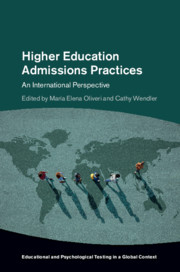Book contents
- Higher Education Admissions Practices
- Educational and Psychological Testing in a Global Context
- Higher Education Admissions Practices
- Copyright page
- Contents
- Figures
- Tables
- Contributors
- Series Editor’s Foreword
- Foreword
- Acknowledgments
- Part I Global Challenges and Common Admissions Models
- Chapter 1 An Overview of Higher Education Admissions Processes
- Chapter 2 Comparing College Aspirations across PISA Countries: Are 17 Percent Oranges Less than 75 Percent Apples?
- Chapter 3 Merit-Based Admissions in Higher Education
- Chapter 4 The Open Admissions Model: An Example from the United States
- Chapter 5 Character-Based Admissions Criteria in the United States and in Europe: Rationale, Evidence, and Some Critical Remarks
- Chapter 6 Cross-Cultural and Global Competencies and Their Role in Admissions Policies and Practices
- Part II Country-Specific Admissions Practices
- Part III Assessments Used in Higher Education Admissions
- Part IV Rethinking Higher Education Admissions
- Index
- References
Chapter 1 - An Overview of Higher Education Admissions Processes
from Part I - Global Challenges and Common Admissions Models
Published online by Cambridge University Press: 09 January 2020
- Higher Education Admissions Practices
- Educational and Psychological Testing in a Global Context
- Higher Education Admissions Practices
- Copyright page
- Contents
- Figures
- Tables
- Contributors
- Series Editor’s Foreword
- Foreword
- Acknowledgments
- Part I Global Challenges and Common Admissions Models
- Chapter 1 An Overview of Higher Education Admissions Processes
- Chapter 2 Comparing College Aspirations across PISA Countries: Are 17 Percent Oranges Less than 75 Percent Apples?
- Chapter 3 Merit-Based Admissions in Higher Education
- Chapter 4 The Open Admissions Model: An Example from the United States
- Chapter 5 Character-Based Admissions Criteria in the United States and in Europe: Rationale, Evidence, and Some Critical Remarks
- Chapter 6 Cross-Cultural and Global Competencies and Their Role in Admissions Policies and Practices
- Part II Country-Specific Admissions Practices
- Part III Assessments Used in Higher Education Admissions
- Part IV Rethinking Higher Education Admissions
- Index
- References
Summary
This chapter provides an overview of the admissions process, the admissions materials requested and how they are reviewed, and how success of the admissions process is measured. It also discusses the need for transparency during the admissions process. Examples from across a variety of world regions are presented to illustrate various admissions models.
- Type
- Chapter
- Information
- Higher Education Admissions PracticesAn International Perspective, pp. 5 - 17Publisher: Cambridge University PressPrint publication year: 2020
References
- 3
- Cited by

